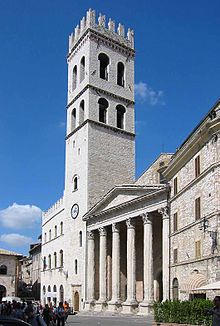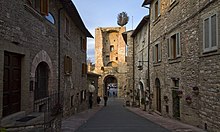Assisi
| Assisi | ||
|---|---|---|

|
|
|
| Country | Italy | |
| region | Umbria | |
| province | Perugia (PG) | |
| Coordinates | 43 ° 4 ' N , 12 ° 37' E | |
| height | 424 m slm | |
| surface | 186 km² | |
| Residents | 28,391 (Dec. 31, 2019) | |
| Population density | 153 inhabitants / km² | |
| Post Code | 06081 | |
| prefix | 075 | |
| ISTAT number | 054001 | |
| Popular name | Assisiati or Assisani | |
| Patron saint |
San Rufino (August 12) |
|
| Website | Assisi | |
 Assisi - panorama from the south |
||
Assisi [asˈsiːzi] is a city with 28,391 inhabitants (as of December 31, 2019) in central Italian Umbria near the regional capital Perugia . It is the birthplace of St. Francis of Assisi (also St. Francis ), the founder of the Friars Minor (today: Franciscans or Minorites ), and of St. Clare , the founder of the Poor Clares .
The medieval townscape with city walls and ruined fortress Rocca Maggiore is still well preserved and was established in 2000 for World Heritage of UNESCO appointed.
geography
Assisi is located about 19 kilometers southeast of the regional and provincial capital Perugia in Zone E, 2 198 GG of the climatic classification of Italian communities .
The districts include Armenzano , Capodacqua, Castelnuovo , Palazzo, Petrignano, Pianello, Rivotorto , Santa Maria degli Angeli , San Vitale, Sterpeto, Torchiagina, Tordandrea and Tordibetto.
The neighboring municipalities are Bastia Umbra , Bettona , Cannara , Nocera Umbra , Perugia , Spello , Valfabbrica and Valtopina .
history
The place ( Latin Asisium , older Ital./Tosk. Ascesi [a'ʃesi] or Scesi , no longer in use today) was founded by the Romans in 399 BC. . BC colonized and terraced on a rocky ridge on the west side of Mount Subasio expanded. He was previously an acropolis of Umbrian . The city walls, the forum (or market square, Piazza del Comune ), a theater , an amphitheater and the Temple of Minerva , which was later converted into the church of Santa Maria sopra Minerva , can still be found from Roman times . In 328 the place was Christianized by today's patron saint Rufino di Assisi (San Rufino).
In 545 the place was largely destroyed by the Ostrogoths , later came under the rule of the Lombards and was then subordinated to the Dukes of Spoleto .
In the 12th century, Assisi became a free commune and was based on Ghibelline principles and was in contrast to the Guelfi neighboring city of Perugia. St. Francis of Assisi , who was born in Assisi in 1181/1182 , was captured as a young man as part of this conflict. In the 13./14. In the 19th century, the city expanded beyond the Roman city walls, the walls were expanded several times.
In the late Middle Ages, Assisi was under the changing rule of the popes, various condottieri, the dukes of Milan and Urbino, and finally came back to the papal state in the 15th century.
The fact that Assisi was saved from fighting and possibly from destruction in 1944 is thanks to the then commander of the German occupation forces, Colonel Valentin Müller , who, among other things, made the declaration of Assisi undefended to the German commander in Italy, Field Marshal Albert Kesselring , open hospital town . At the same time, the Bishop Giuseppe Placido Nicolini and the Franciscan Rufino Niccacci, with helpers from the Catholic Church, organized the political and racist persecution, including many Jews, to be hidden in monasteries and other church buildings.
Attractions
With the basilicas of San Francesco and Santa Chiara , the tombs of St. Francis and St. Clare , Assisi is an important place of pilgrimage for Christianity . The Franciscan hermitage Eremo delle Carceri is worth seeing . On the way there rises the Fontemaggio spring , which supplied the city with drinking water in Roman times.
The double church of San Francesco, the construction of which began in 1228 (built in three levels at the western end of the city), was badly damaged in a severe earthquake on September 26, 1997 , killing four people. Around 75% of the frescoes in the upper and lower church (begun around 1300), which were damaged by the earthquake and were by Giotto and Cimabue , were restored.
The Basilica of San Francesco features as the other Franciscan pilgrimage sites in Assisi since 2000 the World Heritage of UNESCO .
The newer part of Assisi lies at the foot of the mountain around the basilica Santa Maria degli Angeli , which encloses the small portiuncula chapel where Francis died. In 1986 and 2002 the interfaith world prayer meeting took place in this church .
Other buildings worth seeing:
- the Cathedral of Assisi (Cathedral of San Rufino)
- the Santuario San Damiano (outside the city walls)
- the church of Santa Maria sopra Minerva in the central Piazza del Comune; Facade: Roman portico with six columns, built in the 1st century BC Chr.
- the Palazzi Comunali with the Torre del Popolo and the Palazzo del Capitano (built around 1282)
- the Palazzo dei Priori on the Piazza del Comune was started in 1275 and expanded until 1493.
- the Chiesa Nuova church . Was built in 1615 on the initiative of Philip III. and contains frescoes by Cesare Sermei di Orvieto (1609–1668).
- the Church of San Pietro , built around the 10th century, enlarged and renewed in the 13th century. Rectangular, typically Romanesque facade with three rosettes and three entrance portals.
- the amphitheater (built in the 1st century BC)
- the Pinacoteca Comunale
- the Oratorio di San Francesco Piccolino
- the Rocca Minore , fortifications
- Santa Maria Maggiore (church in the center of the village)
- Santa Maria di Rivotorto (2 km below Assisi; the church, built in 1854, was built over a - reconstructed - hut, in which Francis met close colleagues around 1208 or 1209 and laid down the rules of the order with them )
City wall and city gates:
The first city wall was built between the 2nd and 1st centuries BC. By the Romans. These were expanded in 1260. Today's wall ring was built in 1316 with the city gates (clockwise from the north):
- Porta San Giacomo (as the only gate probably already part of the first city wall, later adapted to the conditions of the new wall.)
- Porta Perlici
- Porta dei Cappuccini (also Porta Sant'Antonio)
- Porta Nuova
- Porta Moiano
- Porta Sementone
- Porta San Pietro
- Porta San Francesco
Town twinning
-
 San Francisco , USA
San Francisco , USA
-
 Bethlehem , Palestine
Bethlehem , Palestine
-
 Santiago de Compostela ( Galicia ), Spain
Santiago de Compostela ( Galicia ), Spain
-
 Wadowice , Poland
Wadowice , Poland
sons and daughters of the town
- Properz (lat. Sextus Aurelius propertius; approx. 48 BC – 16. BC), Roman poet of elegance
- Bernhard von Quintavalle (around 1175 – between 1242 and 1245), companion of St. Francis
- Pietro Catanii (before 1180–1221), companion of Francis of Assisi
- Francis of Assisi (1181 / 1182–1226), founder of the Christian Franciscan order
- Clare of Assisi (1193 or 1194–1253), founder of the Order of the Poor Clares
- Agnes of Assisi (1197 or 1198–1253), sister of Saint Clare
- Dono Doni (after 1500–1575), painter
- Gabriel of the Sorrowful Virgin (actually Francesco Possenti, 1838–1862), religious
- Tullio Cianetti (1899–1976), fascist politician
- Andrea Ranocchia (* 1988), football player
literature
- Filippo Raffaelli, Fabio Raffaelli: Passeggiate in Toscana e Umbria. Rome 1984, p. 317 ff.
- Touring Club Italiano : Umbria , Milan 1999, ISBN 88-365-2542-3 , pp. 261-322.
Web links
- Entry on the UNESCO World Heritage Center website ( English and French ).
- www.heini.de: Annotated photos, song of the sun and an overview of the life of St. Francis and St. Clare
Individual evidence
- ↑ Statistiche demografiche ISTAT. Monthly population statistics of the Istituto Nazionale di Statistica , as of December 31 of 2019.
- ↑ Website of the Agenzia nazionale per le nuove tecnologie, l'energia e lo sviluppo economico sostenibile (ENEA) (PDF; 330 kB), accessed on February 20, 2013 (ital.)
- ↑ Official website of ISTAT (Istituto nazionale di statistica) on 2001 population figures in the province of Perugia , accessed on February 20, 2013 (Italian)
- ^ Giovanni Villani, Nuova Cronica, VI / 24: "[...] onde fu cominciatore il beato Francesco nato della città d'Ascesi nel ducato [...]"
- ↑ a b cf. Raffaelli
- ↑ a b c d e f g h cf. TCI
- ↑ Corinna Mühlstedt: Italy in the Second World War: How religious saved Jews from the Nazis , broadcast on June 5, 2019 in the series From Religion and Society of Deutschlandfunk
- ↑ Bethlehem Twinning Cities (English)







